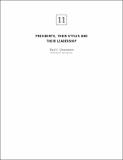| dc.contributor.author | Greenstein, Fred I. | |
| dc.date.accessioned | 2010-06-17T19:30:57Z | |
| dc.date.available | 2010-06-17T19:30:57Z | |
| dc.date.issued | 2005-01-11 | |
| dc.identifier.uri | http://hdl.handle.net/1721.1/55942 | |
| dc.description.abstract | If one set out to design a democracy in which the personal qualities of the top leader could be expected to have an impact on political outcomes, the result might well resemble the political system of the United States. The separation of powers and the Constitutional provision for a president with autonomous powers such as the veto have enabled chief executives to place a personal stamp on the nation's policies since
the founding of the Republic; but until the1930s, Congress typically took the lead in policy making, and the activities of the federal government had little impact on the nation and world. | en_US |
| dc.language.iso | en_US | en_US |
| dc.publisher | Center for Public Leadership | en_US |
| dc.relation.ispartofseries | Center for Public Leadership Working Paper Series;05-11 | |
| dc.rights | Attribution-Noncommercial-No Derivative Works 3.0 United States | en |
| dc.rights.uri | http://creativecommons.org/licenses/by-nc-nd/3.0/us/ | en |
| dc.subject | hks | en_US |
| dc.subject | cpl | en_US |
| dc.subject | kennedy school | en_US |
| dc.subject | leadership | en_US |
| dc.subject | president | en_US |
| dc.subject | politics | en_US |
| dc.title | Presidents, Their Styles and Their Leadership | en_US |
| dc.type | Working Paper | en_US |
